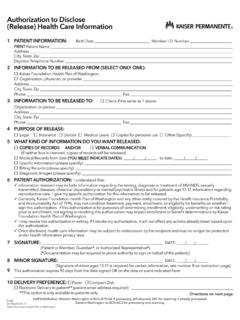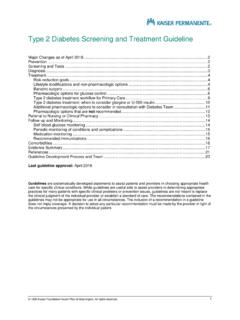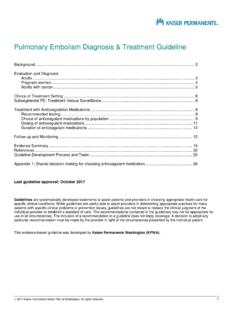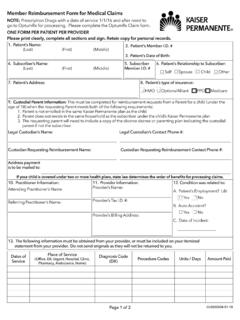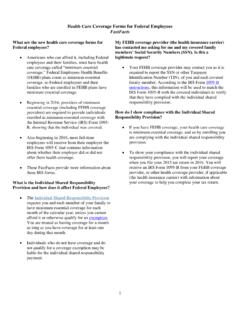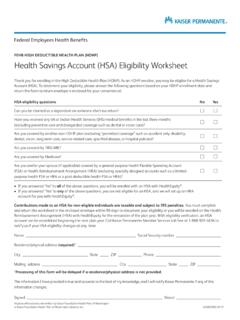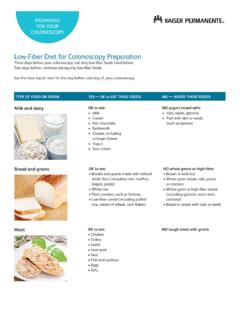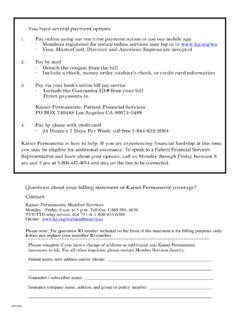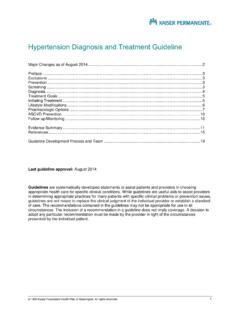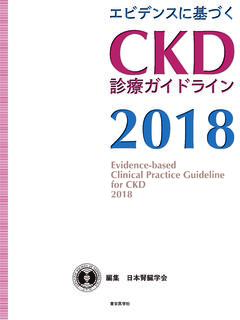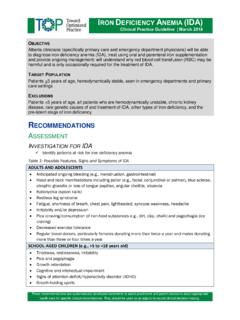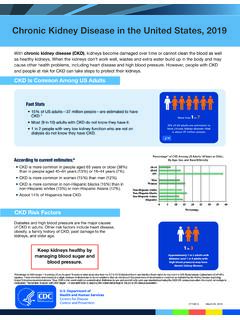Transcription of Atherosclerotic Cardiovascular Disease (ASCVD) Primary ...
1 1996 Kaiser Foundation Health Plan of Washington. All rights reserved. 1 Atherosclerotic Cardiovascular Disease ( ascvd ) Primary Prevention Guideline Major Changes as of October 2020 .. 2 2 Goals of Primary Prevention .. 2 Lipid Screening and ascvd Risk Calculation .. 3 Lifestyle Modifications .. 5 Dietary Supplements .. 6 Statin Therapy .. 7 Shared decision-making: ascvd risk tool .. 9 Antiplatelet Therapy .. 11 Patients with Diabetes: ACE Inhibitor or ARB Therapy .. 12 Lowering Triglycerides to Prevent Pancreatitis .. 13 Medication Monitoring .. 14 Evidence Summary .. 15 References .. 19 Guideline Development Process and Team .. 20 Last guideline approval: October 2020 Guidelines are systematically developed statements to assist patients and providers in choosing appropriate health care for specific clinical conditions. While guidelines are useful aids to assist providers in determining appropriate practices for many patients with specific clinical problems or prevention issues, guidelines are not meant to replace the clinical judgment of the individual provider or establish a standard of care.
2 The recommendations contained in the guidelines may not be appropriate for use in all circumstances. The inclusion of a recommendation in a guideline does not imply coverage. A decision to adopt any particular recommendation must be made by the provider in light of the circumstances presented by the individual patient. 2 Major Changes as of October 2020 New Previous Updated aspirin recommendations: Initiating low-dose aspirin therapy is no longer routinely recommended for Primary prevention, given new evidence that the benefits do not generally outweigh the risks of bleeding. It is appropriate to discontinue aspirin therapy in many patients who are already taking it, with the exception of patients at high Cardiovascular risk (10-year ascvd risk 10%), who may still benefit. Shared decision-making is encouraged. Previous aspirin recommendations: Aspirin is recommended for patients aged 50 59 if 10% risk of ascvd (myocardial infarction or stroke) over 10 years.
3 Use shared decision-making for patients aged 60 69 if 10% risk over 10 years. No recommendation on aspirin for patients under age 50 or over age 70 due to insufficient evidence. Coronary artery calcium (CAC) scores may be helpful for patients at intermediate ascvd risk who are uncertain about taking a statin, and/or for patients whose calculated risk is higher or lower than expected. Coronary artery calcium scoring is not routinely recommended because it does not add significantly to clinical decision-making in a way that improves outcomes. Definitions ascvd , or Atherosclerotic Cardiovascular Disease , is caused by plaque buildup in arterial walls and refers to the following conditions: Coronary heart Disease (CHD), such as myocardial infarction, angina, and coronary artery stenosis > 50%. Cerebrovascular Disease , such as transient ischemic attack, ischemic stroke, and carotid artery stenosis > 50%.
4 Peripheral artery Disease , such as claudication. Aortic Atherosclerotic Disease , such as abdominal aortic aneurysm and descending thoracic aneurysm. Patients with incidental aortic atherosclerosis should follow usual care recommendations for ascvd prevention ( , lifestyle changes, statins). Primary prevention refers to the effort to prevent or delay the onset of ascvd . Secondary prevention refers to the effort to treat known, clinically significant ascvd , and to prevent or delay the onset of Disease manifestations. Goals of Primary Prevention Modify risk factors or prevent their development with the aim of delaying or preventing new-onset ascvd . This guideline addresses the Primary prevention of ascvd in general. It does not attempt to address screening or treatment of specific potential manifestations of ascvd . 3 Lipid Screening and ascvd Risk Calculation Table 1.
5 Lipid screening for patients not already on statins Eligible population Test Frequency Under age 40 Routine screening is not recommended unless patient has a major Cardiovascular risk factor ( , diabetes, hypertension, family history, smoking). Age 40 75 Non-fasting lipid panel Every 5 years at a minimum 1 Over age 75 Routine screening is not recommended. Upon patient request or based on other ascvd risk factors 1 Consider re-screening intervals based on ascvd risk: Every 5 years if ascvd risk < over 10 years Every 2 years if ascvd risk over 10 years Annually if ascvd risk 15% over 10 years and not on statin Lipid screening tests Lipid panel: for most patients The results of a lipid panel total cholesterol, HDL, LDL, and triglycerides ordered through KP HealthConnect include the patient s 10-year risk calculation for Cardiovascular Disease .
6 It is recommended that the patient be non-fasting for the lipid panel, as this is much easier for the patient and does not require a return visit. Any patient who has a triglyceride level > 400 mg/dL (regardless of LDL level) will need to return for a fasting lipid panel. hs-CRP: consider for patients at risk For patients at ascvd risk over 10 years, consider testing with hs-CRP to help confirm elevated risk when deciding whether to recommend statin therapy. Table 2. Interpreting hs-CRP test results Result Interpretation < 1 mg/L Risk is lower than the ascvd risk calculation. 1 3 mg/L Risk is close to the ascvd risk calculation. mg/L Risk is higher than the ascvd risk calculation. 10 mg/L These elevations are associated with a nonspecific inflammatory process. Cardiac risk CRP should be reevaluated after the inflammatory condition has resolved.
7 Coronary artery calcium scoring: consider for patients at indeterminate risk or at intermediate risk and undecided about statins Coronary artery calcium (CAC) scoring is not routinely recommended. However, CAC may be helpful for patients at intermediate ascvd risk who are uncertain about taking a statin, and/or patients whose calculated risk is higher or lower than expected. Who should consider getting CAC score testing? Individuals at intermediate ascvd risk (aged 40 75 years without diabetes and with LDL-C levels 70 mg/dL, at a 10-year ascvd risk of and < 20%), if risk status or decision about statin therapy is uncertain (for example, due to patient reluctance to start pharmacotherapy). For these patients, treatment with statin therapy may be withheld or delayed if CAC = 0, except in cigarette smokers and those with a strong family history of premature 4 ascvd .
8 A CAC score of 1 99 favors statin therapy, especially in those aged 55 years. For any patient, if the CAC score is 100 or 75th percentile, statin therapy is indicated. Measurement of CAC may be considered in select adults with borderline elevated ascvd risk (5 10-year ascvd risk) for further risk stratification, in whom the presence of CAC may change decision-making with regard to statin treatment and intensity of ascvd risk factor modification. If patients get CAC testing but remain untreated, repeating CAC measurement in 5 10 years may have some value in reassessing for CAC progression, but data are limited. Who should not get CAC score testing? Routine CAC measurement is not recommended in patients at low (< 5% 10-year risk) or high ( 20% 10-year risk) ascvd risk, as the results are generally unlikely to change management.
9 Patients who are averse to treatment and unlikely to initiate treatment even if CAC is identified should not undergo CAC testing. Patients should be advised to contact Member Services to determine their coverage benefit for CAC testing, as it may incur out of pocket costs. See Clinical Review Criteria for CT Angiography and CT Cardiography: Screening & Calcium Scores for more information. Note: The Preventive Services Task Force (USPSTF 2018 ) examined whether the addition of coronary artery calcium to the traditional risk factors improves risk classification. The report concluded that while CAC scoring statistically improves risk stratification there was insufficient evidence to determine either the benefits and harms of using CAC score testing for risk assessment, or whether adding it to the tools currently used would reduce the incidence of CHD or mortality following statin therapy.
10 Biomarker tests: not recommended Testing for the following biomarkers of inflammation and lipid-related markers is not recommended. Although they may be independently associated with Cardiovascular Disease risk, they have only a minimal prognostic value when added to conventional risk markers: Fibrinogen Lipoprotein(a) Phospholipase A2 Apolipoprotein B and A-1 combined ascvd risk calculation KP Washington is now using the Pooled Cohort Equation to estimate a patient s risk of developing an ascvd event (myocardial infarction or stroke) over the following 10 years. Use of this risk estimate will help determine which patients might benefit from Primary prevention interventions. The calculations will be returned with the lipid panel results or by using a SmartLink in KP HealthConnect. Note: ascvd risk calculators can only estimate risk.

